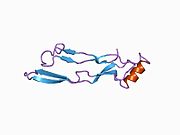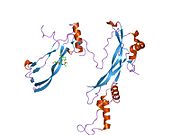Bone morphogenetic protein 7
Ensembl | |||||||||
|---|---|---|---|---|---|---|---|---|---|
| UniProt | |||||||||
| RefSeq (mRNA) | |||||||||
| RefSeq (protein) | |||||||||
| Location (UCSC) | Chr 20: 57.17 – 57.27 Mb | Chr 2: 172.71 – 172.78 Mb | |||||||
| PubMed search | [3] | [4] | |||||||
| View/Edit Human | View/Edit Mouse |
Bone morphogenetic protein 7 or BMP7 (also known as osteogenic protein-1 or OP-1) is a protein that in humans is encoded by the BMP7 gene.[5]
Function
The protein encoded by this gene is a member of the
BMP7 induces the phosphorylation of
Role in vertebrate development
The role of BMP7 in mammalian kidney development is through induction of MET of the metanephrogenic blastema.[8] The epithelial tissue emerging from this MET process eventually forms the tubules and glomeruli of the nephron.[8] BMP-7 is also important in homeostasis of the adult kidney by inhibiting ephithelial-mesenchymal transition (EMT). BMP-7 expression is attenuated when the nephron is placed under inflammatory or ischemic stress, leading to EMT, which can result in fibrosis of the kidney.[9] This type of fibrosis often leads to renal failure, and is predictive of end stage renal disease.[10]
BMP7 has been discovered to be crucial in the determination of ventral-dorsal organization in zebrafish. BMP7 causes the expression of ventral phenotypes while its complete inhibition creates a dorsal phenotype. Moreover, BMP7 is eventually partially "turned off" in embryonic development in order to create the dorsal parts of the organism.[11]
In many early developmental experiments using zebrafish, scientists used caBMPR (constitutively active) and tBMP (truncated receptor) to determine the effect of BMP7 in embryogenesis. They found that the constitutively active, which causes BMP to be expressed everywhere creates a ventralized phenotype, whereas truncated, dorsalized.
Therapeutic application
Human recombinant BMP7 has surgical uses and was originally marketed under the brand name OP1 (discontinued by Olympus Biotech, who bought it from Stryker). It can be used to aid in the fusion of vertebral bodies to prevent neurologic trauma.
BMP7 also has the potential for treatment of chronic kidney disease.[15][16] Kidney disease is characterized by derangement of the tubular architecture by both myofibroblast buildup and monocyte infiltration [17] Because endogenous BMP-7 is an inhibitor of the TGF-β signaling cascade that induces fibrosis, the use of exogenous recombinant BMP-7 (rhBMP-7) could be a viable treatment of chronic kidney disease.[8] It is also thought that BMP-7 reverses fibrosis and EMT through reduction in monocyte infiltration into inflamed tissue.[15] On a molecular level, BMP-7 represses inflammation by knocking down the expression of several pro-inflammatory cytokines produced by monocytes.[15] Reducing this inflammatory stress, in turn, reduces the chance of fibrosis.[9]
Regardless of the mechanism of fibrosis or the origin of myofibroblasts, exogenous BMP-7 has been shown to reverse the EMT process and trigger MET.[8] Eventually this restores the healthy epithelial cell population, and normal function of the kidneys in mice.[8] This is pertinent in humans as well, because many diseases stemming from organ fibrosis occur via the EMT process.[9] The epithelial-menenchymal transition is also problematic in cancer metastasis, so the diminution of EMT with recombinant DNA could have great implications in future cancer treatment options.[9]
BMP7 administration has been proposed as a possible treatment for human infertility due to poor response to FSH treatment.[18]
Promotion of brown fat
It was discovered that mice injected with BMP7 increased their production of "good" brown fat cells, while keeping their levels of the normal white fat cells constant. A BMP7 therapy for obesity in humans may be developed as a result.[19][20]
BMP7 not only stimulates brown adipogenesis,[20][21] it also stimulates the "browning" of brite or beige adipocytes, turning them from a white-like phenotype into a brown-like phenotype (with induction of UCP1 and able to perform non-shivering thermogenesis, which allows to disperse energy as heat).[22]
Other possible effects
Several studies suggest that BMP7 may regulate or affect food intake.[23][21]
References
- ^ a b c GRCh38: Ensembl release 89: ENSG00000101144 – Ensembl, May 2017
- ^ a b c GRCm38: Ensembl release 89: ENSMUSG00000008999 – Ensembl, May 2017
- ^ "Human PubMed Reference:". National Center for Biotechnology Information, U.S. National Library of Medicine.
- ^ "Mouse PubMed Reference:". National Center for Biotechnology Information, U.S. National Library of Medicine.
- PMID 1427904.
- ^ S2CID 22932278.
- PMID 11483516.
- ^ PMID 12915382.
- ^ PMID 19487818.
- PMID 11675415.
- PMID 11846479.
- S2CID 3092348.
- PMID 17989951.
- PMID 22941797.
- ^ PMID 11786084.
- PMID 11918739.
- PMID 11792757.
- PMID 19108831.
- ^ Jha A (2008-08-21). "Obesity: Scientists identify protein that promotes fat-burning". Science. guardian.co.uk. Retrieved 2008-09-03.
- ^ PMID 18719589.
- ^ PMID 22331196.
- PMID 25534037.
- PMID 24066098.
Further reading
- Xiao HQ, Shi W, Zhang Y, Liang YZ (April 2009). "[Effect of bone morphogenic protein 7 on nephrin expression and distribution in diabetic rat kidneys]". Nan Fang Yi Ke da Xue Xue Bao = Journal of Southern Medical University. 29 (4): 671–5. PMID 19403392.
- Murray LA, Hackett TL, Warner SM, Shaheen F, Argentieri RL, Dudas P, Farrell FX, Knight DA (2008). Eickelberg O (ed.). "BMP-7 does not protect against bleomycin-induced lung or skin fibrosis". PLOS ONE. 3 (12): e4039. PMID 19112509.
- Freedman BI, Bowden DW, Ziegler JT, Langefeld CD, Lehtinen AB, Rudock ME, Lenchik L, Hruska KA, Register TC, Carr JJ (October 2009). "Bone morphogenetic protein 7 (BMP7) gene polymorphisms are associated with inverse relationships between vascular calcification and BMD: the Diabetes Heart Study". Journal of Bone and Mineral Research. 24 (10): 1719–27. PMID 19453255.
- Garriock HA, Kraft JB, Shyn SI, Peters EJ, Yokoyama JS, Jenkins GD, Reinalda MS, Slager SL, McGrath PJ, Hamilton SP (January 2010). "A genomewide association study of citalopram response in major depressive disorder". Biological Psychiatry. 67 (2): 133–8. PMID 19846067.
- Reddi AH (July 2000). "Bone morphogenetic proteins and skeletal development: the kidney-bone connection". Pediatric Nephrology. 14 (7): 598–601. S2CID 20757453.
- Gautschi OP, Cadosch D, Zellweger R, Joesbury KA, Filgueira L (2009). "Apoptosis induction and reduced proliferation in human osteoblasts by rhBMP-2, -4 and -7". Journal of Musculoskeletal & Neuronal Interactions. 9 (1): 53–60. PMID 19240369.
- Alarmo EL, Pärssinen J, Ketolainen JM, Savinainen K, Karhu R, Kallioniemi A (March 2009). "BMP7 influences proliferation, migration, and invasion of breast cancer cells". Cancer Letters. 275 (1): 35–43. PMID 18980801.
- Elshaier AM, Hakimiyan AA, Rappoport L, Rueger DC, Chubinskaya S (January 2009). "Effect of interleukin-1beta on osteogenic protein 1-induced signaling in adult human articular chondrocytes". Arthritis and Rheumatism. 60 (1): 143–54. PMID 19116903.
- Yerges LM, Klei L, Cauley JA, Roeder K, Kammerer CM, Moffett SP, Ensrud KE, Nestlerode CS, Marshall LM, Hoffman AR, Lewis C, Lang TF, Barrett-Connor E, Ferrell RE, Orwoll ES, Zmuda JM (December 2009). "High-density association study of 383 candidate genes for volumetric BMD at the femoral neck and lumbar spine among older men". Journal of Bone and Mineral Research. 24 (12): 2039–49. PMID 19453261.
- Dudas PL, Argentieri RL, Farrell FX (May 2009). "BMP-7 fails to attenuate TGF-beta1-induced epithelial-to-mesenchymal transition in human proximal tubule epithelial cells". Nephrology, Dialysis, Transplantation. 24 (5): 1406–16. PMID 19056781.
- Honsawek S, Chayanupatkul M, Tanavalee A, Sakdinakiattikoon M, Deepaisarnsakul B, Yuktanandana P, Ngarmukos S (August 2009). "Relationship of plasma and synovial fluid BMP-7 with disease severity in knee osteoarthritis patients: a pilot study". International Orthopaedics. 33 (4): 1171–5. PMID 19301001.
- Sengle G, Ono RN, Lyons KM, Bächinger HP, Sakai LY (September 2008). "A new model for growth factor activation: type II receptors compete with the prodomain for BMP-7". Journal of Molecular Biology. 381 (4): 1025–39. PMID 18621057.
- Mitu G, Hirschberg R (May 2008). "Bone morphogenetic protein-7 (BMP7) in chronic kidney disease". Frontiers in Bioscience. 13 (13): 4726–39. PMID 18508541.
- Brown A, Stock G, Patel AA, Okafor C, Vaccaro A (2006). "Osteogenic protein-1 : a review of its utility in spinal applications". BioDrugs. 20 (4): 243–51. S2CID 23434940.
- Fajardo M, Liu CJ, Egol K (December 2009). "Levels of expression for BMP-7 and several BMP antagonists may play an integral role in a fracture nonunion: a pilot study". Clinical Orthopaedics and Related Research. 467 (12): 3071–8. PMID 19597895.
- Giannoudis PV, Kanakaris NK, Dimitriou R, Gill I, Kolimarala V, Montgomery RJ (December 2009). "The synergistic effect of autograft and BMP-7 in the treatment of atrophic nonunions". Clinical Orthopaedics and Related Research. 467 (12): 3239–48. PMID 19396502.
- Kalluri R, Neilson EG (December 2003). "Epithelial-mesenchymal transition and its implications for fibrosis". The Journal of Clinical Investigation. 112 (12): 1776–84. PMID 14679171.
- Zhu L, Chuanchang D, Wei L, Yilin C, Jiasheng D (March 2010). "Enhanced healing of goat femur-defect using BMP7 gene-modified BMSCs and load-bearing tissue-engineered bone". Journal of Orthopaedic Research. 28 (3): 412–8. S2CID 12548359.
- Vieira AR, McHenry TG, Daack-Hirsch S, Murray JC, Marazita ML (September 2008). "Candidate gene/loci studies in cleft lip/palate and dental anomalies finds novel susceptibility genes for clefts". Genetics in Medicine. 10 (9): 668–74. PMID 18978678.
- Kron K, Pethe V, Briollais L, Sadikovic B, Ozcelik H, Sunderji A, Venkateswaran V, Pinthus J, Fleshner N, van der Kwast T, Bapat B (2009). "Discovery of novel hypermethylated genes in prostate cancer using genomic CpG island microarrays". PLOS ONE. 4 (3): e4830. PMID 19283074.
External links
- bone morphogenetic protein 7 at the U.S. National Library of Medicine Medical Subject Headings (MeSH)
- BMP7 as Molecule of the Year 2011
- Human BMP7 genome location and BMP7 gene details page in the UCSC Genome Browser.




